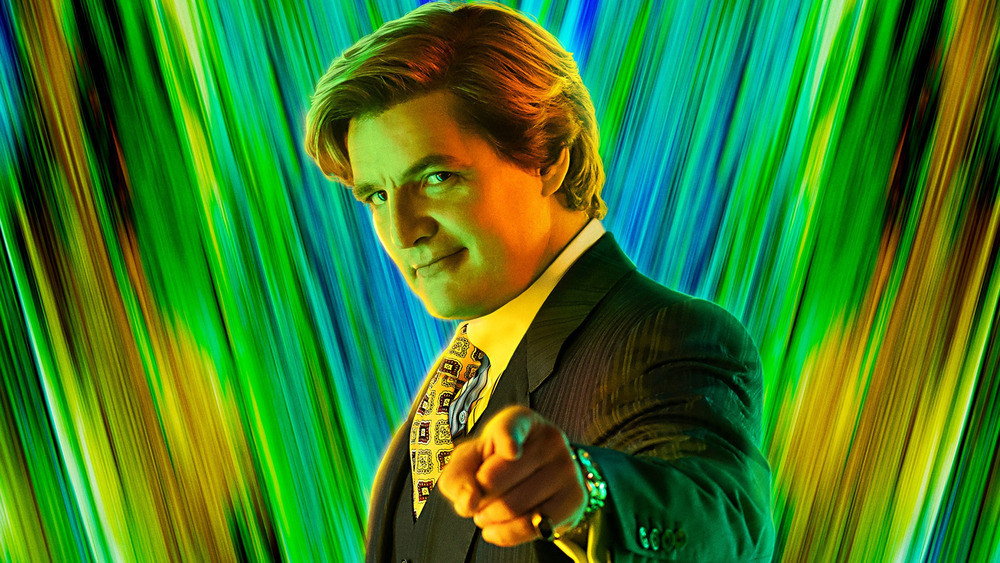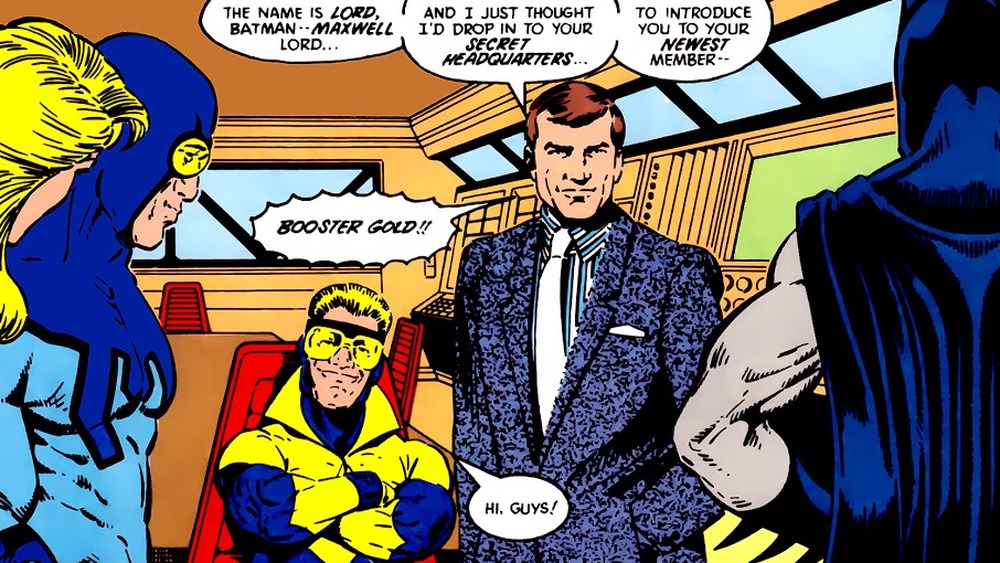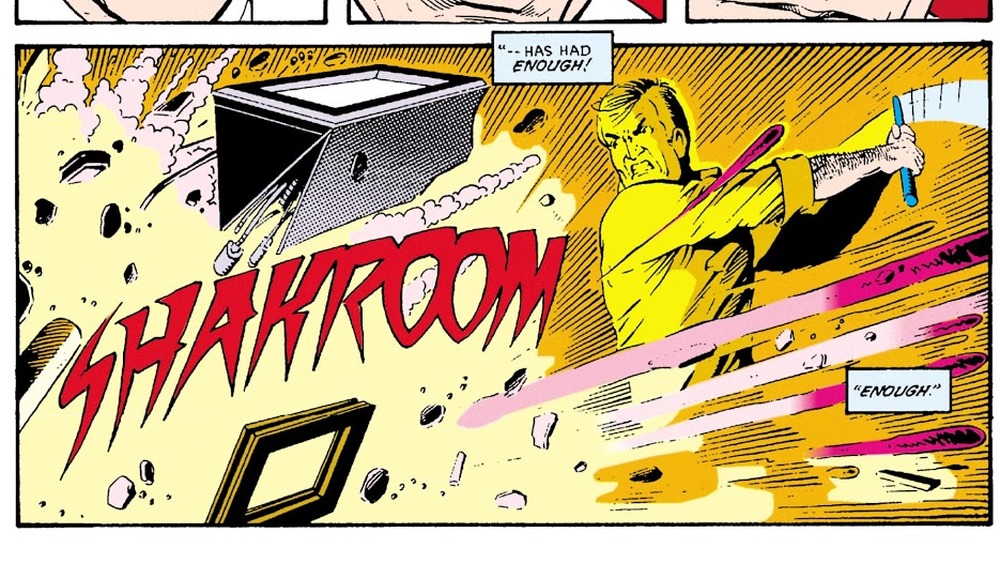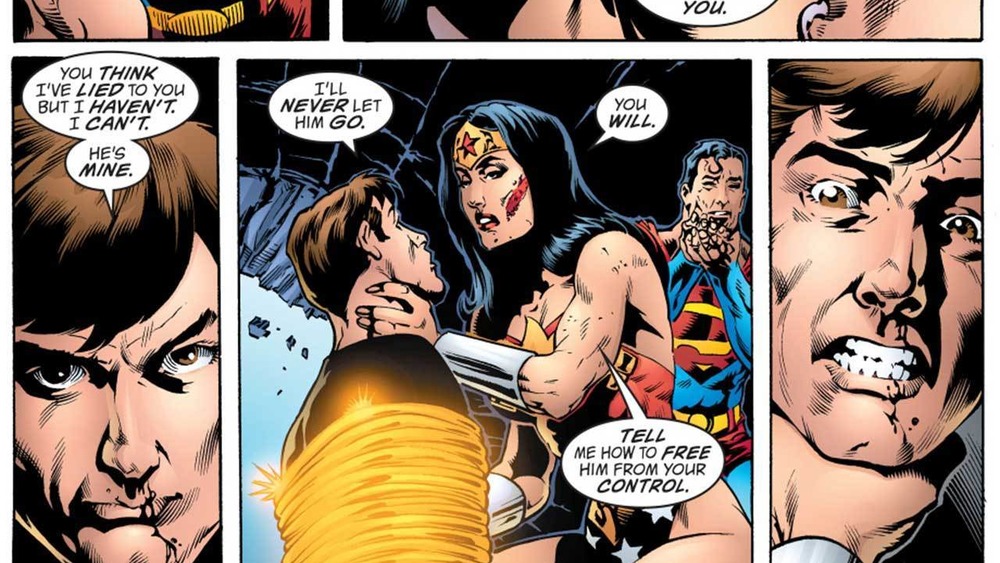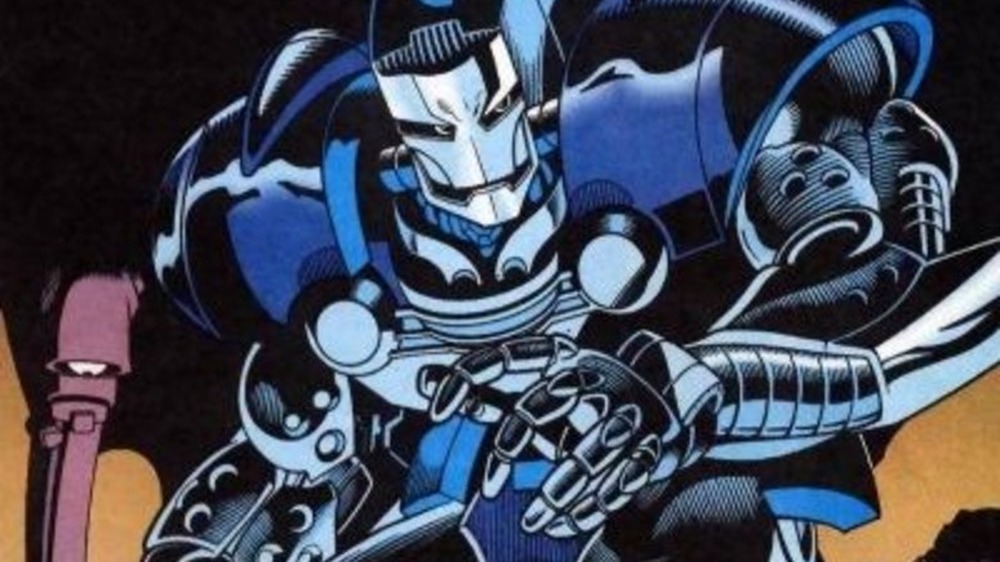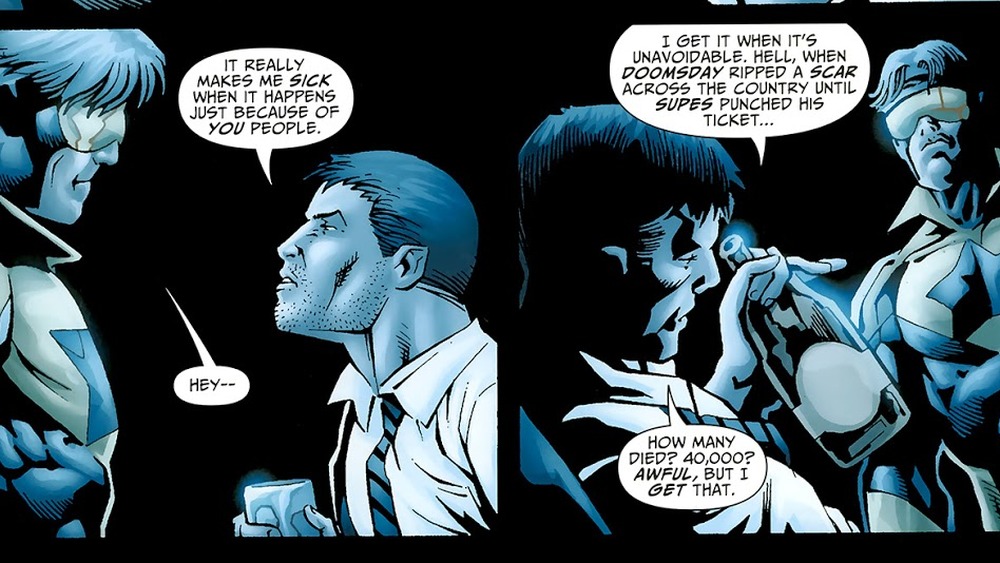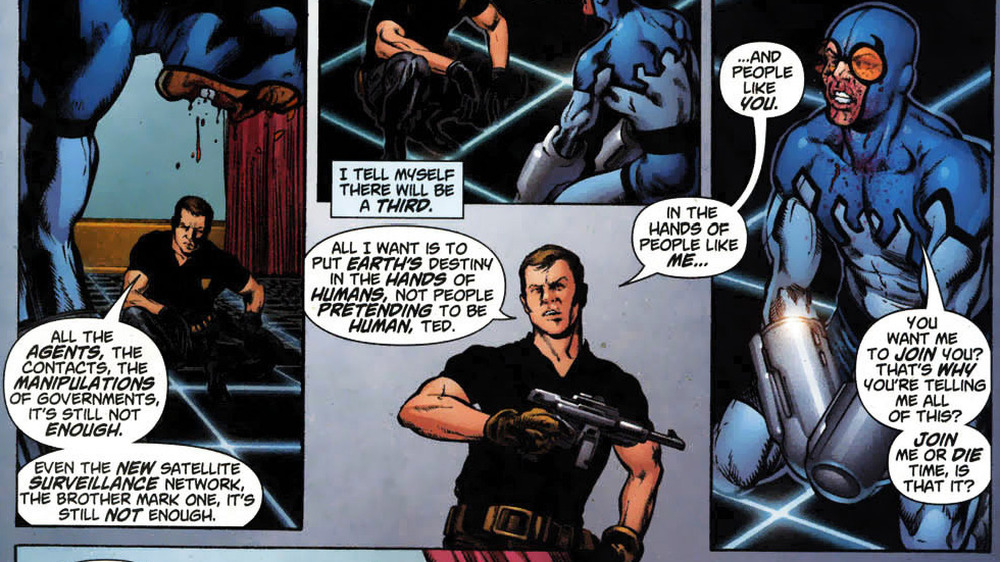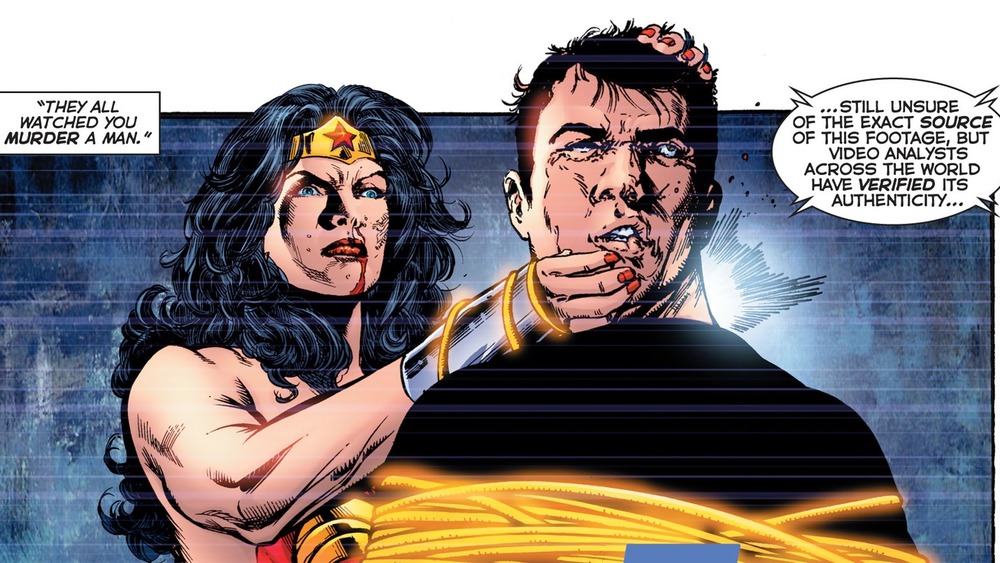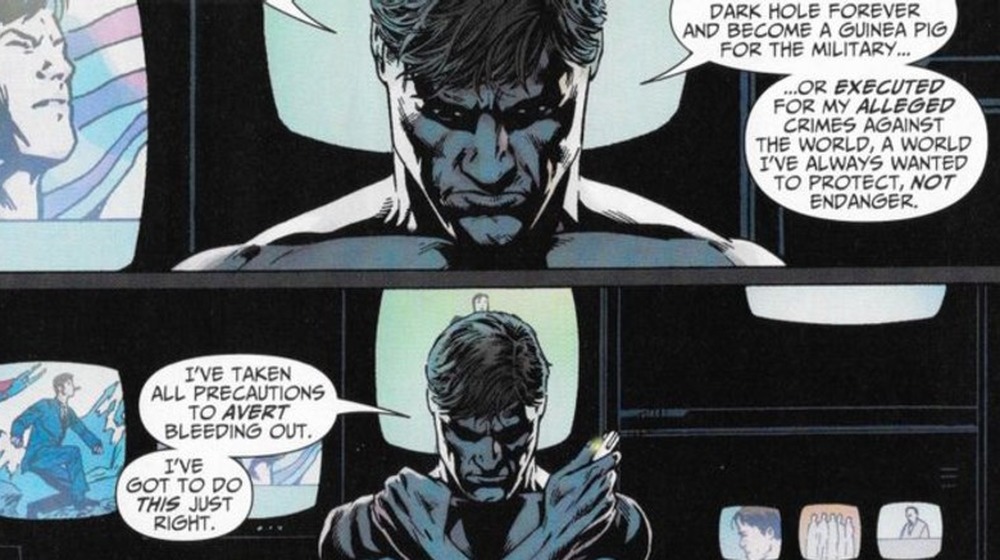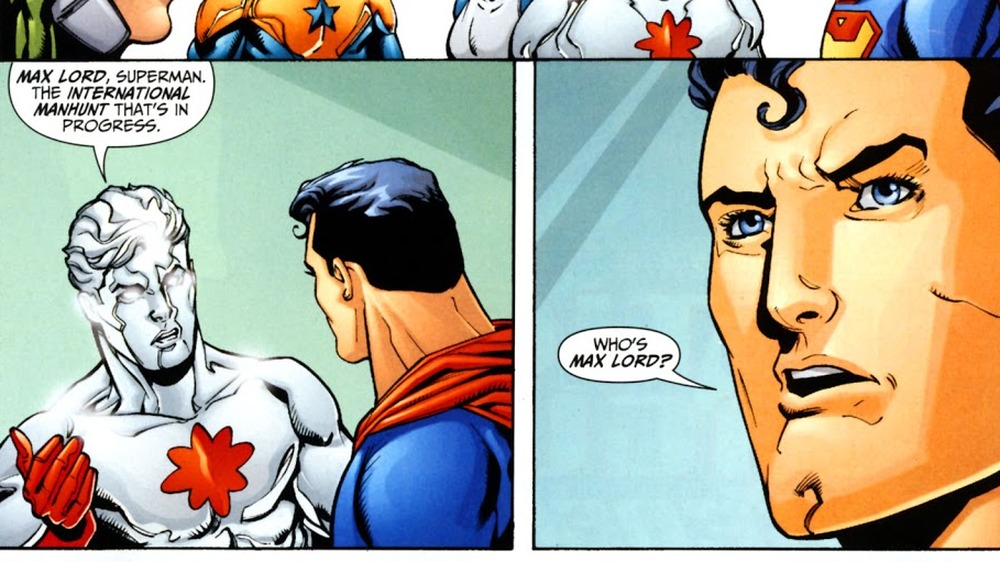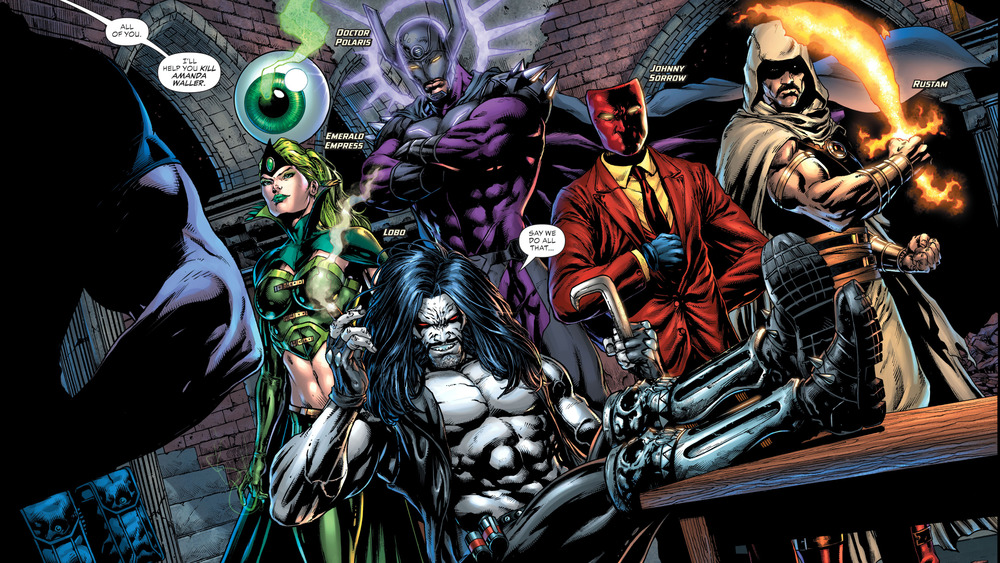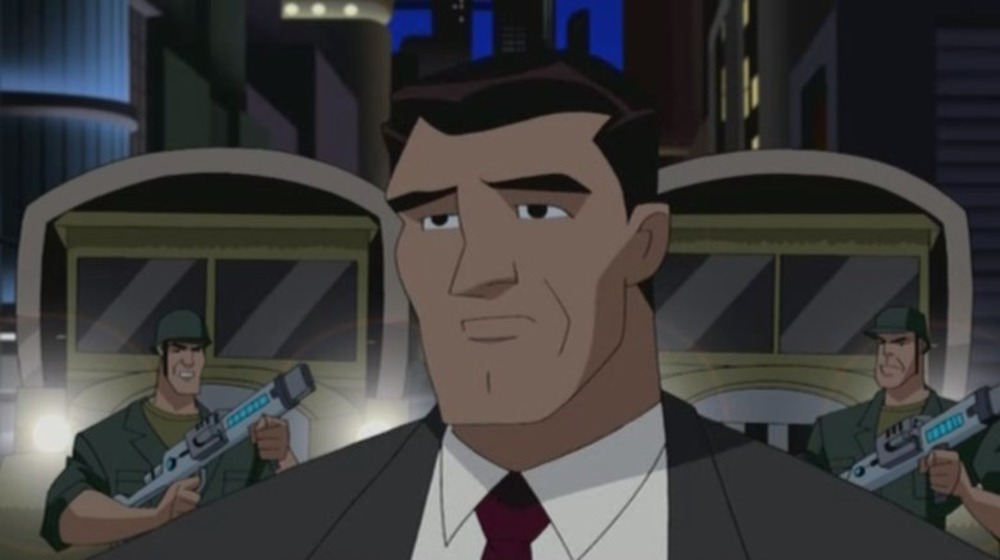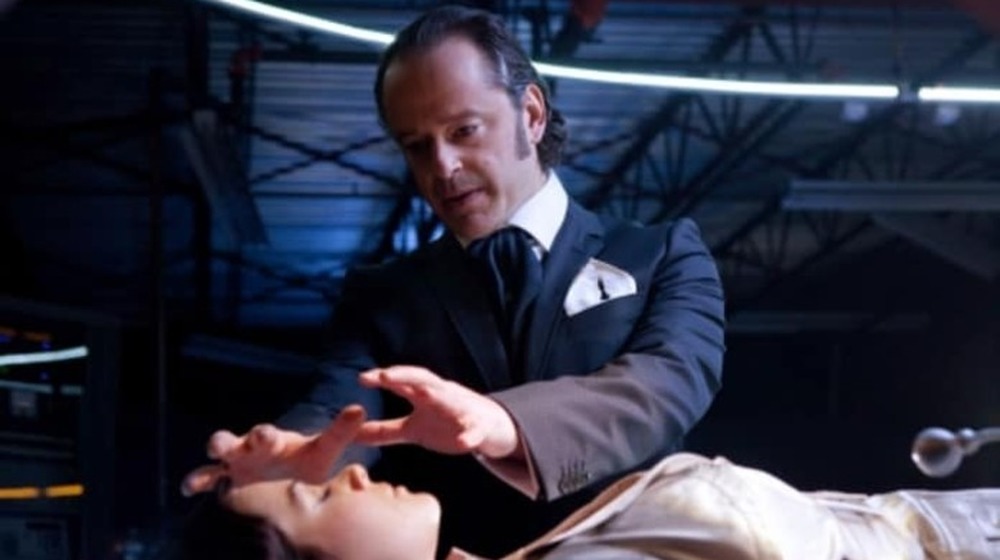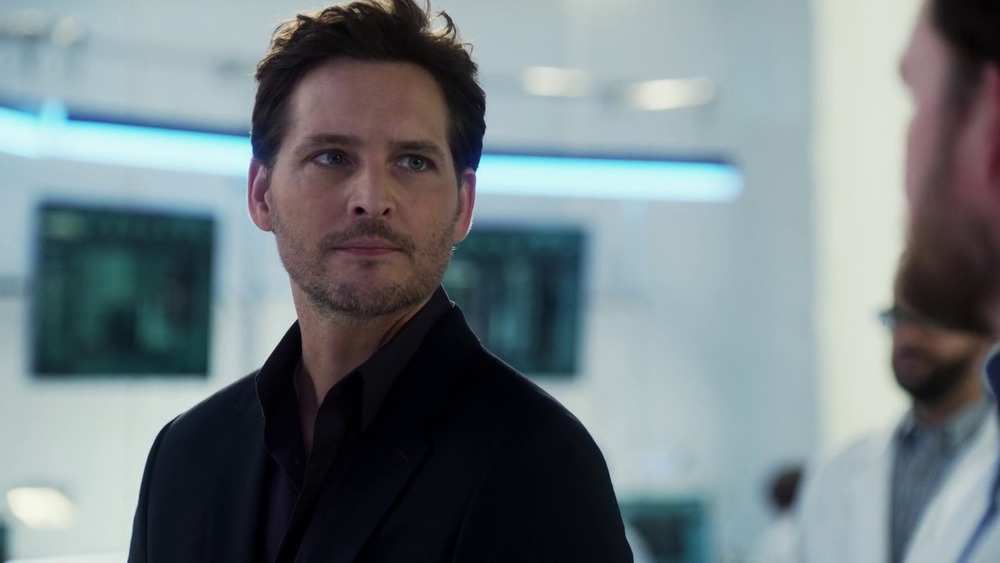The Untold Truth Of Supervillain Maxwell Lord
He doesn't rule a flame-belching world like Darkseid, he can't go ten rounds with Superman like Doomsday, and unlike the Joker, we don't even know if he's ever spent any time in one of Gotham City's few dozen abandoned carnivals. Regardless, Maxwell Lord is one of the more interesting villains you're bound to find in DC Comics. While he's perhaps best known for being one of the bad guys of 2020's Wonder Woman 1984, Lord's been clutching the moral edges of DC's mythos since the late '80s.
Premiering in Keith Giffen and J.M. DeMatteis' game-changing Justice League — the first volume of DC's signature team to follow the 1985-86 event Crisis on Infinite Earths — Maxwell Lord originally appeared as more of a mysterious amoral figure than a villain. But the creative demands of later stories, such as the 2005-06 event Infinite Crisis, would see the character transformed into someone much more diabolical. To learn more about one of DC's most elusive figures, keep reading the untold truth of supervillain Maxwell Lord.
Warning! SPOILERS for multiple comics and TV series follow!
Maxwell Lord, benefactor of the Justice League
In the foreword to the Justice League: A New Beginning trade paperback collection (via The Captain's Unofficial Justice League Homepage), co-writer Keith Giffen says of Lord, "Mystery Max is the driving force behind the [Justice League] — somehow, he enlists an assortment of heroes to form a new Justice League. How he does it, no one is quite certain. Characters themselves don't know what they're doing in the group. ... Only one thing is certain: Max did it."
In his early appearances, Lord is far from the villain he would later become. However, his moral compass wasn't bought at the same store as Superman's, he makes a point of being mysterious, and he doesn't even meet the team he's assembled face to face until the final panel of Justice League #3, when he informs them Booster Gold is joining up. A perfect example of Lord's questionable actions comes in the following issue when Booster Gold impresses the League in battle against the Royal Flush Gang, and it's later revealed Lord hired the villains himself to give Booster Gold the chance to prove himself.
But in spite of his subterfuge and half-truths, Lord sees himself as benefactor of — and ally to — the Justice League. Eventually, that would change.
Lord was a servant of many masters and none
Surprisingly, one of the Maxwell Lord stories that's retconned the most often is one that's arguably the most foundational to the character. In 1988's Justice League International #12, it's discovered that Lord's had a hidden agenda — one so hidden, in fact, even he didn't know about it. A manipulative A.I. created by the New God super-genius Metron has been controlling Lord's actions, hoping to use the Justice League in its plans for global domination. By the end of JLI #12, Lord manages to fight off the computer's control, and he smashes it to pieces.
However, this early story has been changed at least twice. It was eventually revealed that it was the Flash villain Kilg%re — an "electro-mechano-organic intelligence" — who infiltrated Metron's computer and secretly directed Lord's actions. In more recent years, both Metron's creation and the insidious Kilg%re have been at the very least minimized, if not completely forgotten. In 2011's Justice League: Generation Lost #20, when flashbacks piece together Lord's past and motivations, the influence of malevolent electronics is completely forgotten. Lord's reasons for forming the Justice League are portrayed as completely his own.
Maxwell Lord, psychic
As a result of the 1988-89 Invasion! miniseries and line-wide event, the powers of some of Earth's heroes and villains are altered. After the invading Dominators' gene bomb is detonated, some characters notice their powers increase, and others who never had powers in the first place suddenly find themselves among the ranks of the "super." Maxwell Lord is one of the latter, developing irresistible mind control powers in the wake of the event.
Gaining the power to psychically force others to do what he wants doesn't inspire Max to put on a costume and come up with a code name. In fact, early on, he doesn't use his new ability that much. However, when Max uses his power, he goes big. For example, in 2005's Superman #219, Max's abilities fool the Man of Steel into believing he's fighting enemies like Brainiac and Darkseid when he's actually attacking allies like Batman and Wonder Woman. His control over Superman is so complete that Diana is forced to take extreme measures in Wonder Woman #219 to free her friend.
A forgotten death and rebirth
It's not uncommon in superhero comics for heroes and villains and everyone in between to die, only to eventually find their way back to land of the living. In most cases, the characters' deaths and returns act as landmark events. Maxwell Lord's death and strange resurrection, on the other hand, were consciously ignored by DC's creators in the lead-up to the 2005-06 line-wide event Infinite Crisis.
As far as continuity is concerned, by the time Infinite Crisis came around, Maxwell Lord should've been a cyborg. See, Lord dies from a brain tumor, only to be brought back by Kilg%re in a cybernetic body. In later appearances in the 2003-04 miniseries Formerly Known as the Justice League and 2005 issues of JLA Classified, Lord is still a cyborg, but his body resembles that of a human.
But when it comes time for his fateful appearance in the 2005 one-shot Countdown to Infinite Crisis, Lord is a human, and his death and rebirth as a cyborg are completely forgotten. Asked about the choice to ignore Lord's cyborg history at a Wizard World Chicago panel in 2005, Dan DiDio — then DC's vice president-executive editor — explained, "We thought about that aspect of the story some more. And then asked, 'Did anyone read it?' No. 'Did anyone like the idea?' No. So we moved ahead with Max as being a human."
He absolutely hates superheroes
In 2011's Justice League: Generation Lost #20, writer Judd Winick and artist Joe Bennett rewrite the history of Maxwell Lord to put a new spin on his motivations. Among other things, a series of flashbacks stretching across DC's mythology reveal Max's feelings of distrust and loathing toward the world's superheroes.
One of the more revealing flashbacks takes place shortly after one of the darkest moments in DC Comics — the destruction of the fictional Coast City at the end of 1993's Superman #80. A drunk Max sits in front of a wall of TV monitors, all displaying different news reports on the Coast City story. Booster Gold enters and asks Lord if there are any new developments. We soon learn Lord's mother is one of the victims lost in Coast City's destruction, and Lord blames superheroes. He says to Booster Gold, "You ever wonder if you guys — just by being around — are doing more harm than good?"
Now, you could see this simply as a man understandably venting while grieving, but the flashback ends with Max using his power to force Booster Gold into forgetting the conversation took place — implying that even back then, he was planning to make some bold moves against the world's heroes.
Maxwell Lord steals Batman's spy satellite
For most of Max Lord's earlier appearances, he either worked on the side of DC's heroes, or he walked a moral tightrope. But Lord fell hard into the dark precipice beyond that tightrope during the lead-up to Infinite Crisis.
In the 2005 one-shot Countdown to Infinite Crisis, Ted Kord (aka Blue Beetle) discovers someone has siphoned funds from his company and believes something larger is at work. He tries to find allies to help his investigation, but most of the other heroes dismiss his concerns. Kord eventually discovers that Max Lord is behind his company being near bankruptcy. Worse, he learns that Lord used his early years as the Justice League's benefactor to gather intel on them, and he's hijacked Batman's Brother Eye satellite to monitor superheroes all over the world. DC Comics shocked fans in the closing moments of the issue by having Lord murder Blue Beetle with a shot to the head.
Lord proves to be an architect of one of the multiple threats facing DC's heroes during the event — the OMAC Project. Using the data collected from Brother Eye, Lord injects humans with a nanovirus that turns them into superpowered cyborgs who hunt metahumans.
Wonder Woman murders Maxwell Lord
One of Max Lord's greatest victories comes at the cost of his life. In the "Sacrifice" storyline, which ties in with The OMAC Project miniseries — running through all of Superman's titles and ending in 2005's Wonder Woman #219 — Lord uses his psychic abilities to make Kal-El go wild. With Max's illusions making him believe they're villains, Superman attacks allies like Batman and Martian Manhunter. Wonder Woman and Superman lock horns in an epic, two-issue battle until Diana discovers that Lord is behind her friend's rampage. Under the Lasso of Truth's influence, Lord admits his death is the only way Superman will be freed from his control. Seeing no other way to stop Superman from going on another rampage, Wonder Woman breaks Lord's neck, killing him.
What makes it a victory for Lord? Well, unbeknownst to Diana, Brother Eye records Lord's execution and broadcasts it across the globe. The footage causes the distrust and fear of superheroes already bubbling in the general public to boil over, as well as creating a divide between Wonder Woman and compatriots like Batman and Superman. As a result, Infinite Crisis begins with the world's heroes divided and distracted precisely when they need unification more than ever.
Lord returns in Blackest Night
In superhero comics, characters come back from the dead all the time. Usually, the story behind a character's resurrection is distinct, but every now and then, creators use a line-wide event to bring back characters in bulk. A perfect example of this is the 2009-10 event Blackest Night. The villain Nekron resurrects just about every dead DC superhero and villain you could think of as soldiers in his war against the Green Lanterns and the other heroes. Maxwell Lord is one of the many characters brought back by Nekron's power.
In the connecting miniseries Blackest Night: Wonder Woman, Lord makes a try at vengeance against his killer. Using the power of the Black Lanterns to bring zombified soldiers to help him, Lord attacks Wonder Woman in Arlington National Cemetery. Neither Lord nor his risen soldiers survive the battle, though at the end of Blackest Night, Lord is revived once more by the power of the White Light — the light of creation from which the powers of the Green Lanterns and all the other interstellar light-based groups (e.g. Star Sapphires, Sinestro Corps, Red Lanterns) spring.
He makes the world forget his name
Blackest Night is followed-up by the 2010-11 event Brightest Day, during which Max Lord performs one of his most epic displays of power.
As part of Brightest Day, in 2010, Justice League: Generation Lost launched with Keith Giffen — one of the writers who created Lord — complete with heroes largely pulled from the Giffen/J.M. DeMatteis era of the team. The heroes focus on capturing Maxwell Lord, who's the subject of a massive international manhunt. Far from being deterred by his death at the hands of Wonder Woman, Lord feels everything that's occurred proves the universe sees his goals as important. In Justice League: Generation Lost #1, he challenges his old friend Booster Gold with, "You've gotta ask yourself, Booster, when one of the most powerful beings on the planet murdered me ... and the universe sought fit to send me back ... who's right?"
Before the end of Generation Lost's first issue, the heroes hunting Lord have the entire world behind them. But then things get more complicated. Lord hooks himself up to a device designed to amplify his powers, and he nearly kills himself using them. We see waves of power traveling across the Earth (without knowing what they're for) and Lord bleeding profusely. As the issue ends and Justice League members reach out to law enforcement agencies and other superheroes, they learn Lord used his powers to make everyone in the world forget him. The only people spared are the Leaguers hunting him and a few others discovered later.
Maxwell Lord vs. Amanda Waller
In 2011, DC's New 52 event reboots its superhero mythos, and Maxwell Lord returns as the head of the covert ops agency Checkmate. Four years later, DC launched their Rebirth initiative, incorporating pre-New 52 elements with their new continuity, and Maxwell Lord had the honor of being one of the villains behind the very first Rebirth event – Justice League vs. Suicide Squad.
While publicized as an event revolving around a conflict between the two titular groups, Lord reveals there's more going on at the end of 2017's Justice League vs. Suicide Squad #1. As the Justice League and Suicide Squad clash in the fictional nation of Badhnisia, Lord uses his mental powers to free the villains comprising what we learn was the original Suicide Squad line-up in New 52 continuity — Doctor Polaris, Emerald Empress, Lobo, Johnny Sorrow, and Rustam. Using them and the power of Eclipso, Max pursues his goal of "saving the world" from superheroes.
Lord's plans fail, and when he's in custody, we learn Amanda Waller is the true villain of the piece. Max realizes she manipulated him to create a conflict that would ultimately convince the Justice League to not interfere with her Suicide Squad. It seems Max's death is initially one of Waller's goals as she orders Killer Frost to murder him, but Frost refuses. Instead, Justice League vs. Suicide Squad #6 ends with Lord being inducted into Task Force XI, Waller's own squad of powerful telepaths.
On Justice League Unlimited, Maxwell Lord recruited the Super Friends
Years before Wonder Woman 1984 or even his earliest live-action appearance, Maxwell Lord shows up in the season 1 Justice League Unlimited episode "Ultimatum," voiced by Tim Matheson. Just as he does in the Giffen/DeMatteis Justice League comic, Lord appears as a super team's public face, but rather than the Justice League, he's spinning for the Ultimen — a team of heroes unwittingly working for Amanda Waller's Project Cadmus.
Like his comic book counterpart, Justice League Unlimited's Maxwell Lord is concerned about the power superheroes wield. He involves himself with the Ultimen because he wants the government to have its own team of metahumans. Unlike the Lord of the source material, however, he never displays any super powers during "Ultimatum".
The Ultimen are no innocent "recruits." The team eventually discovers they're artificially created lifeforms implanted with false memories, and their unconventional creation has given them terminal conditions. Except for Long Shadow (Gregg Rainwater), the Ultimen go wild, forcing the Justice League to step in. As characters, the Ultimen are an interesting mash-up of past stories. The individual members are based on heroes from the '70s Super Friends cartoon, like the Wonder Twins, Black Vulcan, and Apache Chief. Conceptually — as government sponsored metahumans who don't know they're dying — they're pulled from the Ultramarines Corps (which premiered in 1998's JLA #24), a group working for the corrupt General Wade Eiling and clashing hard with the League.
Maxwell Lord made his live-action debut on Smallville
Long before Pedro Pascal stepped into the DC universe, the first actor to play a live-action version of Maxwell Lord was Gil Bellows, who landed a recurring role as Lord on season 9 of Smallville.
Perhaps the biggest difference between Bellows' brief time as Lord and most other portrayals of the character is there's never any pretense that Max is just a charismatic television personality or super team benefactor. Lord shows up in "Charade" as the Black King of Checkmate. While Smallville's Lord doesn't appear to have the ability to control minds as he does in the comics, he does have the power to psychically extract memories from others. And believing that most metahumans need to be eliminated to keep the world safe, Lord is happy to help disgraced former district attorney Ray Sacks (Dylan Neal) learn the identity of a hero known as the Blur (really, Clark Kent) by probing Lois Lane's (Erica Durance) mind.
Lord's only other appearance is a couple of episodes later in "Hostage." Tess Mercer (Cassidy Freeman) finds herself in some kind of run-down house, being pursued by Lord, who demands to know the location of the Book of Rao. Tess realizes it's an illusion and finds herself on a table with Lord scanning her mind. She escapes, and Lord calls the mysterious Red Queen (Annette O'Toole) to inform her. He's then incapacitated by some kind of sonic attack over the phone, though it isn't revealed what happens to him after that.
In Supergirl's first season, Maxwell Lord makes war on the last daughter of Krypton
In the comics and in most of his television incarnations, Max Lord allies himself with shadowy government agencies because of his distrust toward superheroes. But when Peter Facinelli plays him as one of the antagonists of the first season of CW's Supergirl, it's the government Max Lord doesn't trust. Of course, when Lord learns secrets about the eponymous hero, he does his best to expose her. He also sends more powerful villains after her, such as the Bizzaro Supergirl clone. But while he's a genius trained in combat, Supergirl's Max Lord never shows any metahuman powers.
Lord is eventually imprisoned by the Department of Extranormal Operations, only released when the agency and Supergirl (Melissa Benoist) needs his help. He then spends the rest of the show's first season as a sometimes-ally to Supergirl. And in the season finale, Lord gives the Kryptonite bombs that he's developed to General Sam Lane (Glenn Morshower), Lois Lane's father.
